 |  |
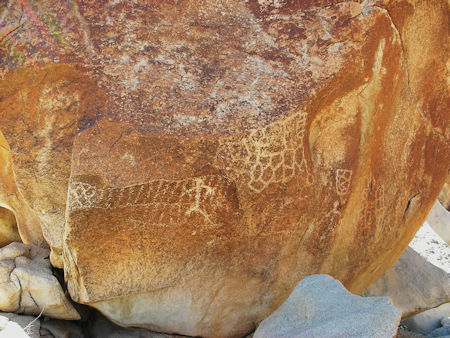
By David Kier
Baja California has all three styles of prehistoric artwork. Used seemingly to convey a message, an idea, or an event. Visiting these sites or examining the photographs can be both interesting and educational. Understanding their meanings may be something for future generations to interpret. Keeping these sites unmarked by vandalism should be of utmost concern so that future generations can view them and ponder their meanings. They serve as a valuable attraction for people to explore and get outdoors.
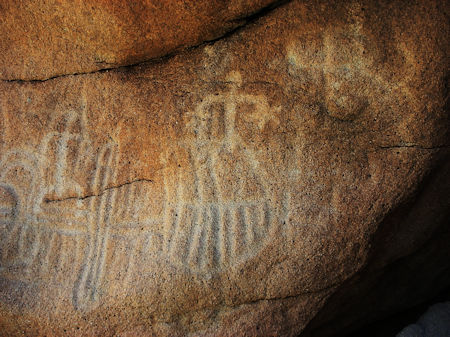
Petroglyphs are made by scratching, rubbing, or chipping at rock surfaces. Pictographs are painted rock surfaces. Geoglyphs are larger, ground markings made usually by trenching or clearing away rocks and the top layer of soil, in patterns or lines that stand out from the natural surface.
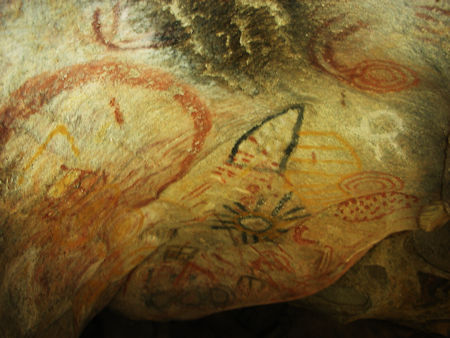
Most of the sites are known and published which has allowed many of us to enjoy viewing them in person. Photographs taken of the sites is one way they are preserved should they become damaged or destroyed by Nature or human activity. Once in a while, while traveling in the backcountry, it is possible to discover these artifacts from the past simply on accident. The sites are everywhere on the peninsula so do keep an eye open for them.
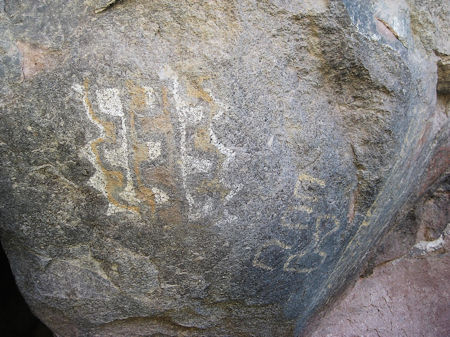
One petroglyph site is called Cañon la Vibora (Rattlesnake Canyon) and is just a few miles south of the Guadalupe Canyon Hot Springs entrance, near Laguna Salada. This region was once very busy with Indian activity. Pottery pieces are scattered about and there are many morteros (grinding holes in boulders where food was prepared). We visited the site in 2008 while camping in Guadalupe Canyon. When a friend recently showed us photos of the same petroglyphs from his 2019 trip, it was very pleasing to see them unblemished. This location is best reached in a four-wheel-drive vehicle. As Mama Espinoza was famous for saying, “bad roads bring good people” and so it goes with this site.
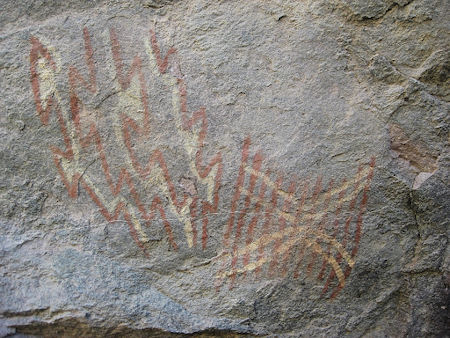
Pictographs are colorful since they are painted rock faces. One of the best known of these sites is close to Highway One, just 2 miles north of Cataviña.
Another pictograph location was well known since the 1960s. It is six miles off of the road to Mission San Borja and called Montevideo. My last visit was in 2017 and unfortunately, since then, a fence midway to the site was added with a locked gate that prevents visitors from seeing it.
Geoglyphs are more puzzling as to their meaning. Many can be viewed using satellite images as some are quite large and are unrecognizable on the ground. Who were these made for? Someday, I hope to learn more about these sites. One site we found on accident. It was south of Mexicali and near Km. 113, west of Highway Five.
A geoglyph discovered in 1987 by Marvin Patchen, while flying over Baja near El Mármol, became a quest to find and examine it from the ground. They reached the site on foot in 1989. In the 1991 Rock Art Papers, Volume 8, Edited by Ken Hedges, is the entire story of its discovery. See the Patchen geoglyph at 29° 56.493'N, 114° 49.888'W, and another is just over a mile west at 29° 56.435'N, 114° 51.102'W.
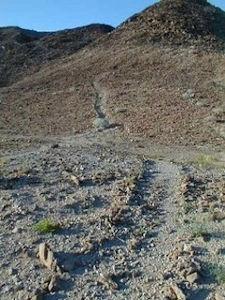
Enjoy the wonders of Baja California and help them last for generations to enjoy by respecting these sites. Avoid touching painted rock surfaces and don’t be adding anything new at an ancient site.
To read more about petroglyph sites in Baja California:
TV’s ‘America Unearthed’ Goes to Baja
Finding Petroglyph Park
El Rosario Petroglyphs
More on pictograph sites in Baja California:
The Painted Cave of San Borjitas
Montevideo Rock Art
Painted Cave of El Carmen
About David
David Kier is a veteran Baja traveler, author of 'Baja California - Land Of Missions' and co-author of 'Old Missions of the Californias'. Visit the Old Missions website.

Easy to buy! I didn’t have to use it, so no clue on that front

Have used different times with different vehicles and each time was very simple - each time we have...

I reapplied for my Baja Bound Mexican car Insurance yesterday and I spoke to Ms. Shauna. This lady...